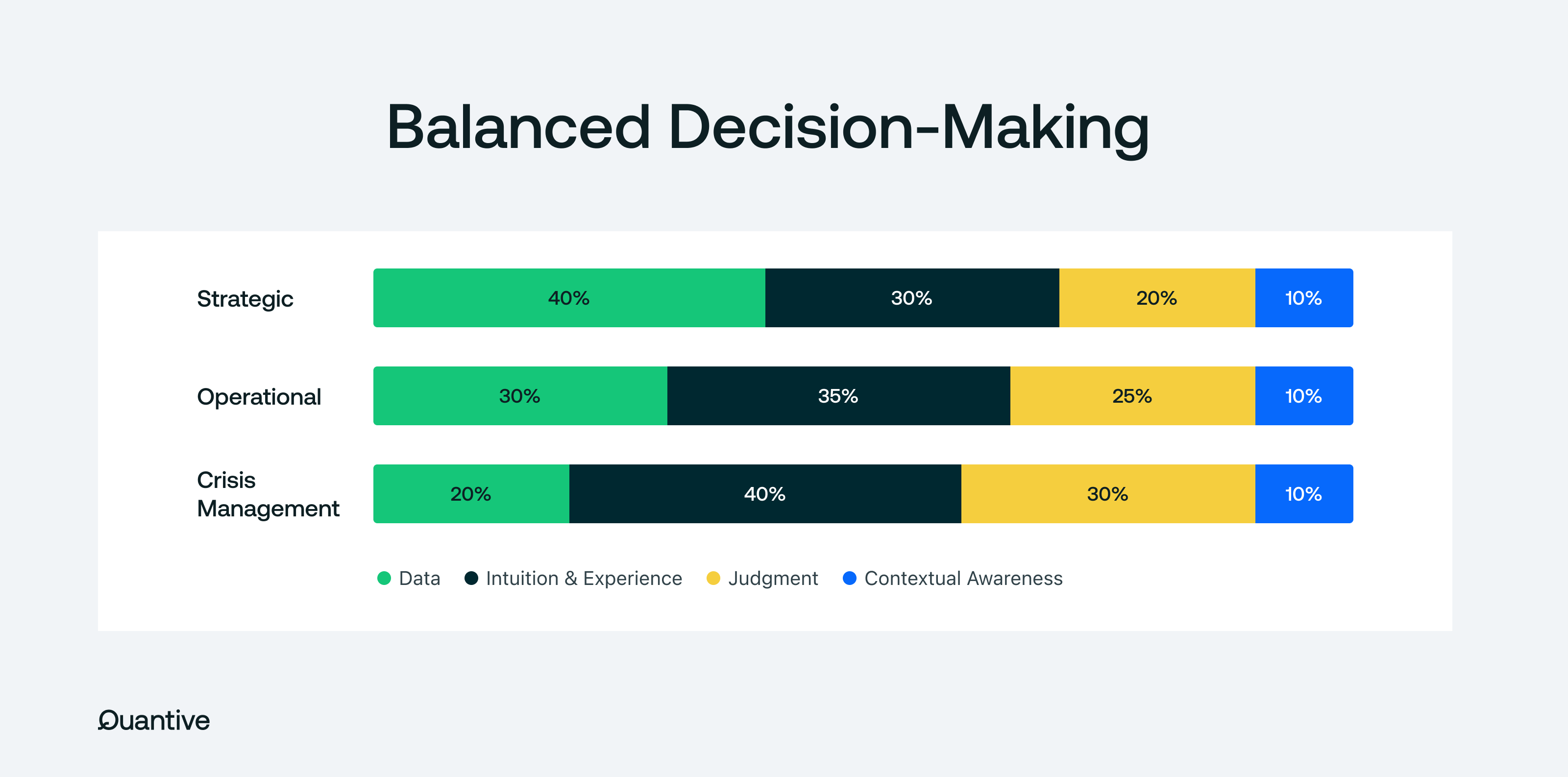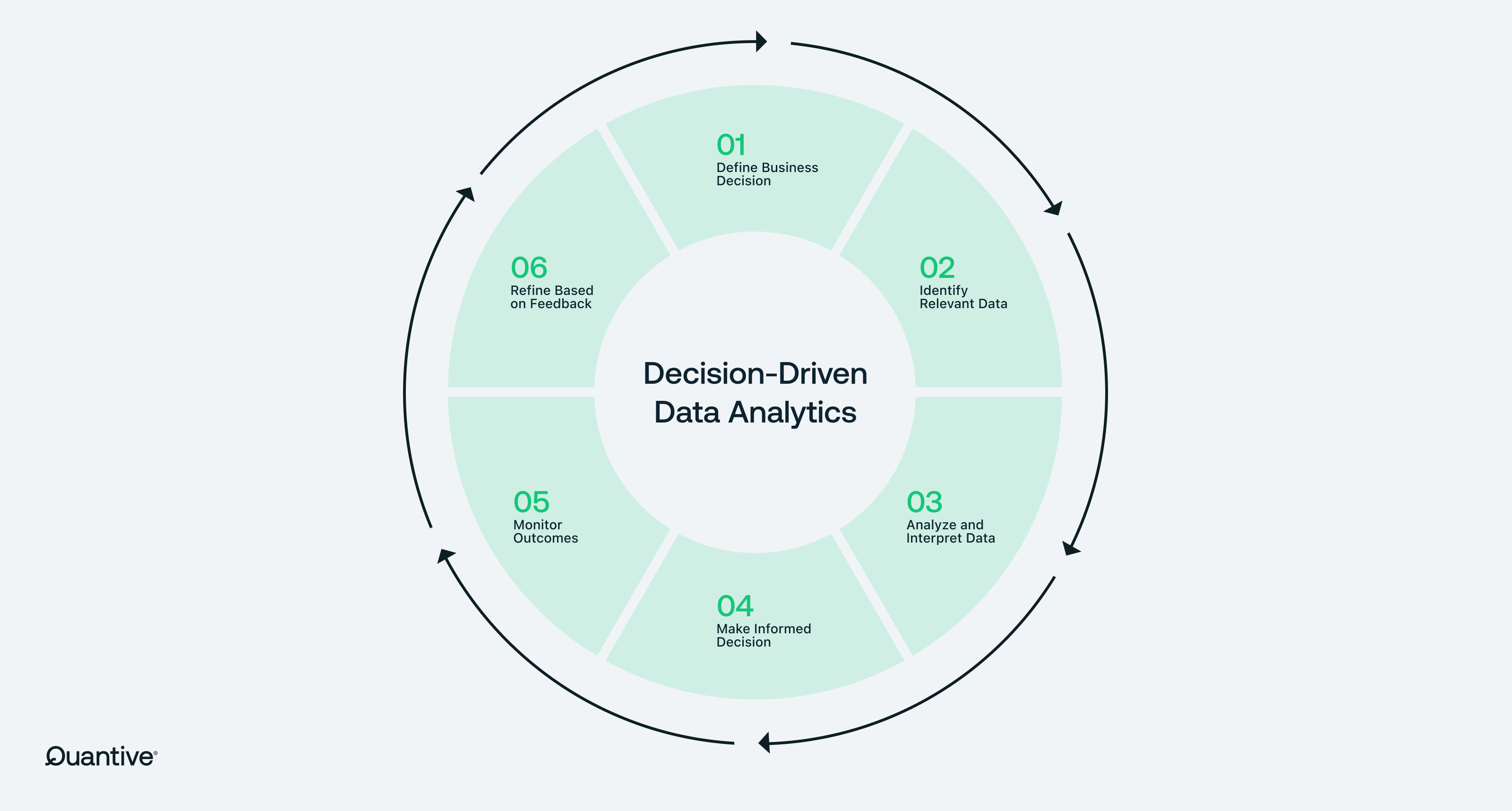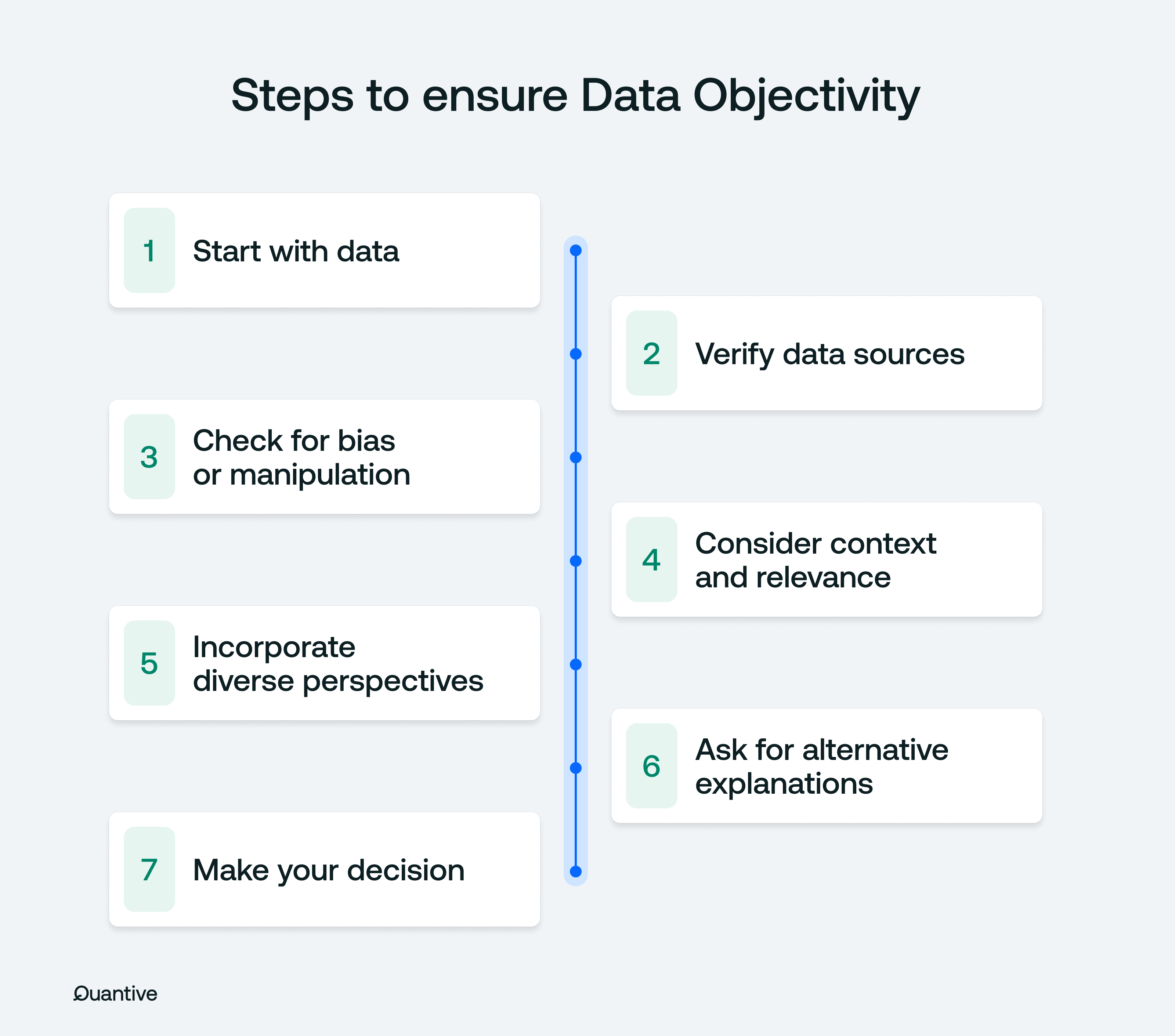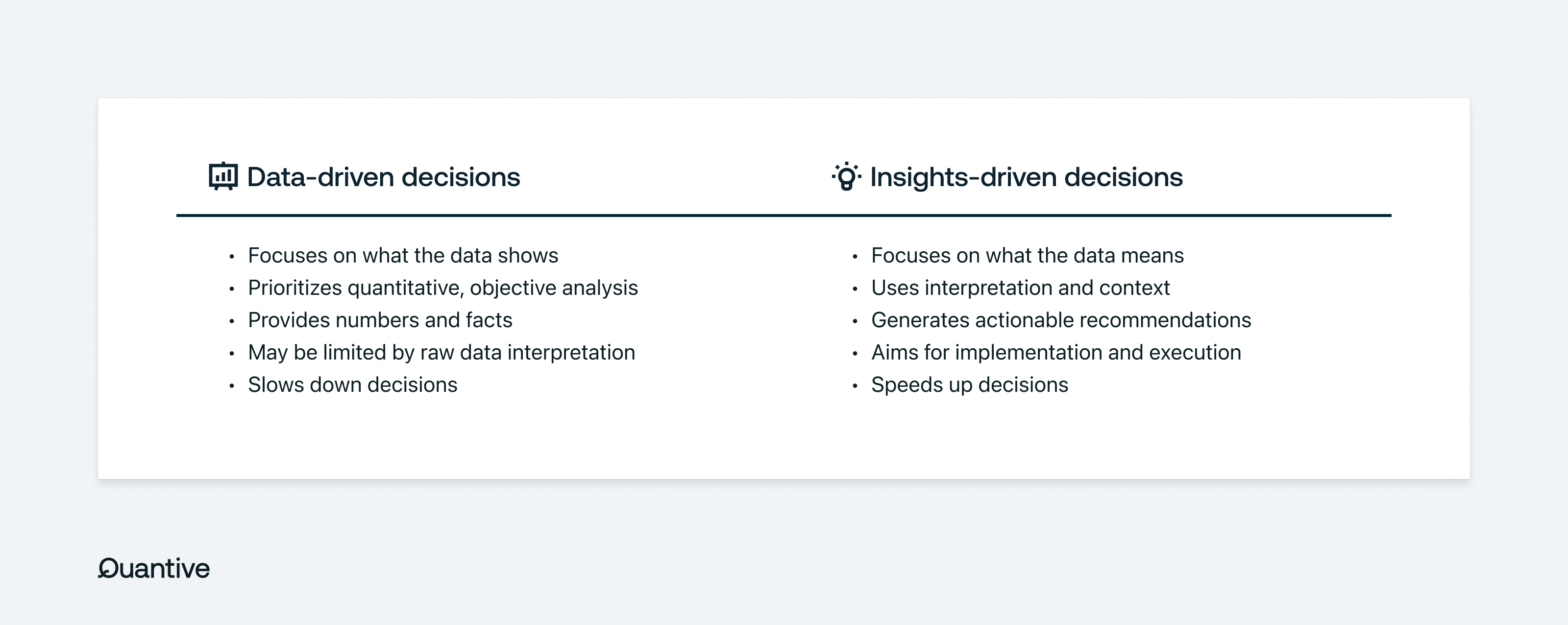Quantive is now part of WorkBoard. Get to know WorkBoard:
Have you ever noticed how some businesses treat data-driven decision-making almost like a cult? Well, that's no surprise since we generate an enormous amount of data daily — 402.74 million terabytes, to be exact. (Statista) This is like filling up over 87 billion DVDs with information every single day.
With so much data at our fingertips, making decisions should be easy. But it's not. Data overload adds complexity to the decision-making process. At the same time, without the right tools, it's easy to cloud human judgment and slow progress.
This article will debunk the common myths surrounding data-driven decision-making, explain what it is, why we need it, and how leaders can avoid common pitfalls by using Quantive StrategyAI.
Before we dive deeper into the myths, let’s see what data-driven decision-making is.
What is data-driven decision-making?
Data-driven decision-making (DDDM) involves making decisions based on data and insights. Some definitions describe it as an alternative to relying solely on gut feelings or intuition. However, we want to clarify that DDDM doesn't replace intuition or professional judgment. Intuition can guide you in a specific direction, while data helps validate or challenge your assumptions. This balance between them helps you make a truly informed strategic decision.
A data-driven decision-making process requires the entire company to embrace this mindset — from leadership to team members. You can support this shift by providing data collection and analysis tools and technology. Additionally, teams need training on using these tools, when to use them, and how to turn data insights into actionable decisions.
One of the most effective ways to encourage data-driven decision-making is through regular reviews of initiatives. By having a process for frequent evaluation of performance with data, teams can adapt their future strategies and optimizations based on actionable insights.
How Quantive StrategyAI Helps Foster Data-Driven Decision-Making
Quantive StrategyAI brings your data out of silos and turns it into insights to guide decisions. With our platform, you always have real-time insights into strategic initiatives at your fingertips and are ready to inform your next decisions and strategic moves. Connecting all your data points ensures you're always working with up-to-date information on business performance and strategy progress. This allows you to stay informed, pivot when necessary, and quickly adapt to changes — all driven by data and insights.
Why data-driven decision-making is important?
When we face a decision, we often realize the pressure and stress it can create. Strategic decisions, in particular, demand mental focus and a process that builds confidence in the next steps. Data is the key to ensuring peace of mind, accountability, and transparency.
Data-driven decision-making helps leaders:
Suppress cognitive biases
Biases distort reality. By relying on objective data, we minimize these biases and make decisions based on facts, not assumptions or emotions.
Example: You might believe a product is successful because of feedback from a few vocal customers. However, when you evaluate its performance using data, you find that the results don't match your expectations. By diving into the analytics, you confront your assumptions and gain a clear picture of the product's actual performance. Now, you have the insights needed to decide strategically about its future.
Gain certainty and control
Our brains naturally seek patterns and certainty in a complex world. The more ambiguity we face, the more anxiety and stress we experience. Data provides clarity, insights, and concrete evidence to navigate uncertainty.
When you encounter unknowns, like market shifts or changing customer behavior, data reduces the fear of the unknown and helps create a clear path for your next strategic moves.
Reduce decision fatigue
When overwhelmed by too many decisions, data can streamline your options. Instead of weighing multiple choices, data helps you reduce uncertainty, saving time and mental energy.
For instance, deciding where to invest resources might feel overwhelming if your company has numerous product lines. Using data to identify which products have the highest growth potential simplifies decisions and reduces confusion.
Improve accountability and transparency
In a data-driven culture, teams follow a unified approach to evaluating options and making decisions. Data-driven decisions can be tracked, measured, and reviewed. This transparency shifts the focus from assigning blame to finding solutions.
For example, if data shows a particular initiative is underperforming, the team can shift their efforts toward analyzing the problem and brainstorming solutions rather than pointing fingers.
The problem with data-driven decision-making
Data-driven decision-making gives leaders the control, certainty, and accountability they need. It ultimately builds confidence in managing complex business environments. However, it also leads to another problem: human limitations.
The human brain can sometimes fall into extremes — seeing things in black and white. But in reality, there’s a lot of gray.
That's why it's essential to recognize the potential pitfalls of data-driven decision-making and learn how to avoid them.
Let's start with:
Myth #1: All decisions should be data-centric
When was the last time you made an impulsive decision? Maybe it was when you bought that can opener on Black Friday or approved the budget for the next fiscal year.
Let's be real — our brains don't make purely rational decisions. Even when we think we're being logical, a mix of gut feelings and instinct is always involved.
So, why do we often try to limit intuition and rely only on data for strategic decision-making?
It's simple.
Leaders fear losses more than they value gains.
Data is invaluable in strategic decision-making because it generates critical insights (when interpreted correctly), helps identify patterns, and minimizes guesswork. It’s an excellent tool for measuring performance, predicting trends, and making informed decisions based on historical evidence.
Leaders feel confident when their decisions are backed by solid data, knowing they’ve significantly reduced risk and that their choices are grounded in facts.
However, the problem with relying solely on data is that:
- Conclusions can be flawed if the data is incomplete, outdated, or inaccurate
- Data ignores human judgment, which can identify nuances that data might miss
- Too much data can be overwhelming or used to support pre-existing beliefs (confirmation bias)
- It doesn't account for broader contexts like market shifts or cultural factors, which can heavily influence strategic executive decisions
- It overlooks qualitative factors like employee morale, customer sentiment, and brand reputation
These issues highlight that data should support and guide strategic decisions, not dictate them.
Data doesn't make decisions. Leaders do.
Data provides valuable insights, but ultimately, the leader's experience, judgment, and intuition shape the final decision.

The myth in practice
A great example is Hewlett-Packard's (HP) acquisition of Compaq in 2001. Initially, the merger seemed bad because data predicted HP's stocks would drop, leading to financial losses.
However, the CEO, Carly Fiorina, believed in the long-term benefits of this decision as her observations showed that the market was slowly shifting from consumer to enterprise services. In the short term, HP's stock fell, but by 2006, the company's revenue doubled, securing a significant share of the global PC market.
What initially seemed like a bad move became a pivotal success, thanks to years of experience, professional intuition, and a keen understanding of the competitive landscape.
That's the power of combining data, insights, and human judgment.
How Quantive StrategyAI helps
Quantive StrategyAI turns large amounts of data into strategic insights. It gives you AI-powered analysis to complement your judgment and expertise. Quantive StrategyAI does the time-consuming work of analyzing your data and guiding you through strategic frameworks to make decisions. This ensures a balanced approach, helping you make informed decisions without relying solely on data and avoiding decision paralysis.
Myth #2: Refrain from decision-making if data is not available
Have you ever felt paralyzed when you had to make an important decision with high stakes?
Leaders often hesitate to act without concrete data, fearing losses. This hesitation comes with high risks and costs from slowing down the process.
Conversely, it’s hard to trust your instincts when the company or board expects every decision to be backed by quantitative insights. As a result, leaders delay or skip important decisions, leading to missed opportunities, increased costs, and a decline in trust.
The myth in practice
We all know how brands like Apple, Amazon, and Netflix made bold moves based on intuition instead of data. But you may have missed Spanx's story of how a big move based on intuition paid off. Here it is:
Sara Blakely launched her shapewear product without any market research or data. She invested her savings, relying purely on personal experience and intuition to identify a gap for women wanting smoother silhouettes. She started her business from her personal need for a new type of shapewear that would solve her own problem. She trusted that if she had this need, then other women likely faced the same challenge, even though she had no data to support this assumption.
Ultimately, the risk paid off — Spanx is now a thriving, privately held company.
But what if she never made that move?
Not all decisions can be made with data. Sometimes, we need to take the risk and test the hypothesis by collecting the data we need to evaluate our decisions.
This is the difference between data-driven decisions and decision-driven data analytics.
Decision-driven analytics uses data to answer critical business questions or optimize strategic choices. Whatever decision you make (especially when you lack the data to back it up), this approach helps you monitor results and continually revisit data to inform and optimize future decisions.

How Quantive StrategyAI helps
Even without perfect data, Quantive StrategyAI helps you frame decisions by highlighting key areas to investigate or refine, guiding you toward the right strategic choice to move your business forward. This allows you to make decisions confidently, rally your teams behind strategic initiatives, and gather real-time data to know what you need to adjust.
Myth #3: More data means better decisions
Analysis paralysis is a common challenge when you have too much data. What happens to the brain when it's exposed to too many options? It shuts down. That's right!
The human brain simply can’t handle too much information at once. The more data you have, the more you fear missing something important, leading to hesitation and second-guessing. In the end, more data doesn’t guarantee better decisions. Sometimes, it just makes it harder to decide at all or pushes you to rely on the data that’s easiest to understand
The real issue is that data alone doesn’t guide decision-making. Insights do.
The myth in practice
The perfect example is what happened to Yahoo. They had a chance to acquire Google early but passed despite having all the right data. While the data may have been there, Yahoo’s decision was likely influenced by a lack of awareness of emerging market trends and a narrow focus on its existing offerings.
Yahoo struggled to keep up as Google took over search ads and became a tech giant.
Yahoo's attempts to compete led to several disjointed acquisitions, worsening its internal data complexity. Human biases and slow decision-making further added to their challenges. Ultimately, the company had too much unstructured data, no clear offerings, and a lack of a solid business strategy. Yahoo couldn't act quickly on product innovations or capitalize on market opportunities.
Years ahead, Yahoo struggled with data complexity and overload. Their experience illustrates the need to avoid these pitfalls by embracing tools like Quantive StrategyAI, which help remove human biases, generate strategic insights, and guide innovation.
If we could extract actionable insights from Yahoo’s story, it would be:
- Define clear goals: Focus data collection around key business objectives.
- Actionable insights: Prioritize data that drives decisions.
- Data integration: Streamline and consolidate systems.
- Real-time analytics: Leverage tools that deliver immediate insights.
- Simplify reporting: Provide digestible, clear insights.
- Flexible process: Balance data with innovation.
- Review strategies: Continuously evaluate and adapt.
How Quantive StrategyAI helps
Quantive StrategyAI rapidly processes your internal data while layering in the external environment to make sense of the complex data needed to make each decision. You can confidently navigate complexity and make quicker, smarter decisions through proven strategic frameworks.
Myth #4: Data is always objective
Not if it's incomplete or misinterpreted.
A recent study shows we must drink at least 4 cups of coffee daily for its anti-cancerogenic benefits. If we base our decision solely on this insight, we might also end up with insomnia, digestive issues, and addiction. Here comes the human judgment and interpretation to evaluate whether this insight is in our favor.
Data is as objective as the person who reads it.
Sometimes, hidden agendas play a big role in interpretation. This is especially true when there are:
- Pressure to meet targets and expectations (especially investors')
- Ambition for promotion or recognition
- Poor ethical standards
- Fear of negative consequences
- Focus on short-term wins
Data can be manipulated intentionally or unintentionally, and pressure, values, and ethical standards within an organization influence both behaviors.
The myth in practice
Here are two stories that you might remember:
In 2016, Wells Fargo employees were pressured by aggressive sales targets and intentionally manipulated data by opening millions of unauthorized customer accounts. The scandal led to significant fines, reputational damage, and a loss of trust in the bank.
In 2012, when news about a possible flu outbreak spread, more people searched for flu symptoms — even if they weren’t sick. Google’s Flu Trend predictive model overestimated flu cases by nearly 50%. The data wasn’t inherently wrong; more people appeared to have symptoms, but it was influenced by external factors that weren’t initially considered.
Ultimately, companies need clear standards for catching and preventing both intentional and unintentional data manipulation.
How to keep data objective
As a leader, one way you can help create standards for data integrity that build trust is always to investigate it and ask critical questions.
Here's a list of questions to help you out:
- Where exactly did this data come from, and can we trust the source?
- Is the data objective, or is it being used to support a specific narrative?
- Is our data complete, or are we missing something outside our data set?
- Does the data apply to the decision or problem we're solving right now?
- Are we considering the broader context — market shifts, cultural factors, and trends?
- Does this data align with our company values and ethical standards?
- Have we considered external influences, like biases or outdated information?
- Have we explored alternative perspectives or explanations for what this data tells us?

How Quantive StrategyAI helps
Quantive StrategyAI eliminates bias and ensures internal and external factors are not missed. It highlights real trends and outliers that could be missed or manipulated in manual analysis, ensuring decisions are truly data-informed and not skewed by human error or hidden agendas.
How do technology and AI debunk the data-driven decision-making myths?
Before we dive in, ask yourself: Do I want my company to be data-driven or insights-driven?
The difference between the two is… AI.
Quantive StrategyAI is the world's first AI-powered strategy management platform that helps businesses move from purely data-driven to insights-driven. How? By turning raw data into meaningful, timely, and actionable insights. AI adds context and objective recommendations to inform better decisions.
Here's a quick comparison:

Shifting to insights-driven decision-making requires investing in AI technology. You can assess whether your business is ready for this shift by considering several factors:
Volume and data complexity
Large data sets make traditional methods less effective at processing and analyzing information. Rather than getting stuck in data analysis, AI can quickly manage big data and deliver actionable insights. This will allow you to focus on strategic decisions instead of sifting through data.
Need for real-time insights
Markets are shifting quickly, and businesses must stay agile and ready for pivots. AI delivers immediate insights and gives you constant feedback on the business's performance. AI can deliver insights in real-time for rapid, more informed actions.
Data accuracy and predictions
Raw data is less useful without considering industry trends, market conditions, and business performance. AI helps businesses understand why certain trends occur and how they influence the strategic course. Platforms like Quantive StrategyAI also use predictive analytics to forecast future trends based on historical and real-time data.
Bias and subjectivity
How often do you make decisions under high pressure?
How often do you face cognitive biases, like confirmation bias (using data to support pre-existing beliefs) or anchoring bias (relying too heavily on recent performance)?
These are valid reasons to implement AI. If trained with unbiased data and algorithms, AI can provide insights based purely on objective facts. Let’s say your sales team favors a product they've always sold well, but AI might show that customer preferences are shifting. By processing data faster and objectively, AI helps eliminate bias and ensures decisions are based on facts, not assumptions.
Decision mapping and hypothesis generation
You need this when making complex decisions involving multiple variables or uncertainties. AI helps you quickly explore various paths and test assumptions to make better-informed data-backed decisions.
Solutions like Quantive StrategyAI help you explore possible outcomes by generating and testing assumptions. You can map out strategic options, such as entering a new market, and form hypotheses like, “If we lower prices, we will capture X% market share.”
Final words
Making strategic decisions is already complex, and it’s even more overwhelming when you have data issues — no data, unreliable data, or overflowing data. Quantive StrategyAI cuts through the noise and helps you avoid the data decision-making pitfalls that many are prone to.
With real-time analysis, strategic insights, and objective recommendations, Quantive StrategyAI ensures the appropriate use of data in driving smarter decisions and actionable plans you can implement immediately. No matter the challenge, Quantive StrategyAI equips you to lead confidently and adapt quickly to change.





